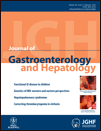Histological features responsible for brownish epithelium in squamous neoplasia of the esophagus by narrow band imaging
Abstract
Background and Aim
Esophageal squamous neoplasias usually appear brown under narrow band imaging as a result of microvascular proliferation, and brownish color changes in the areas between vessels, referred to as brownish epithelium. However, the reasons for the development of this brownish epithelium and its clinical implications have not been fully investigated.
Methods
Patients with superficial esophageal neoplasias treated by endoscopic resection were included in the study. Areas of mucosa with brownish and non-brownish epithelia were evaluated histologically.
Results
A total of 68 superficial esophageal neoplasias in 58 patients were included in the analysis. Of the 68 lesions, 32 were classified in the brownish epithelium group, and 36 in the non-brownish epithelium group. Brownish epithelium was significantly associated with a diagnosis of high-grade intraepithelial neoplasia or invasive cancer (P < 0.0001). Thinning of the keratinous layer, thinning of the epithelium, and cellular atypia were significantly associated with brownish epithelium by univariate analysis, and thinning of the keratinous layer and thinning of the epithelium were confirmed to be independent factors by multivariate analysis. The odds ratios were 9.6 (95% confidence interval: 2.0–46.3) for thinning of the keratinous layer, and 4.6 (95% confidence interval: 1.1–19.4) for thinning of the epithelium.
Conclusions
Brownish epithelium is an important finding in the diagnosis of esophageal squamous neoplasia, and may be related to thinning of the keratinous layer, caused by neoplastic cell proliferation, and thinning of the epithelium.




